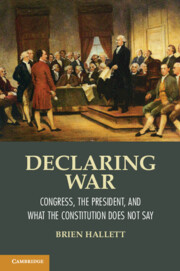Book contents
- Frontmatter
- Contents
- List of Figures
- Acknowledgments
- Prologue
- Miscellaneous Frontmatter
- 1 A Constitutional Tyranny and Presidential Dictatorship
- Part I What Is the History?
- Part II What Is a Declaration of War?
- Part III What Are the Solutions?
- Part IV What Is the Theory?
- 10 Bellum Justum et Pium
- 11 The Rule of Law
- Epilogue Senator Malcolm Wallop
- Appendix I Five Congressional Declarations of War and One Appropriations Act
- Appendix II The Fœderative Powers in Parliamentary Governments
- References
- Index
Epilogue - Senator Malcolm Wallop
Published online by Cambridge University Press: 05 November 2012
- Frontmatter
- Contents
- List of Figures
- Acknowledgments
- Prologue
- Miscellaneous Frontmatter
- 1 A Constitutional Tyranny and Presidential Dictatorship
- Part I What Is the History?
- Part II What Is a Declaration of War?
- Part III What Are the Solutions?
- Part IV What Is the Theory?
- 10 Bellum Justum et Pium
- 11 The Rule of Law
- Epilogue Senator Malcolm Wallop
- Appendix I Five Congressional Declarations of War and One Appropriations Act
- Appendix II The Fœderative Powers in Parliamentary Governments
- References
- Index
Summary
Succinct and insightful explanations of the power to declare war are few and far between. However, they do exist and can be found, often in the most usual places. For example, who would ever think to pick up the Congressional Record and turn to the Senate debate of Wednesday, 24 October 1990? The debate that day concerned an effort to overturn President George H. W. Bush’s veto of the Civil Rights Act of 1990, known also as the Kennedy-Hawkins Bill. The vetoed bill was an effort again to outlaw certain discriminatory employment practices that had recently been struck down by the Supreme Court.
For Senator Malcolm Wallop, Republican from Wyoming, however, civil rights was less pressing an issue than the war against Iraq for the liberation of Kuwait. With less than two weeks before the midterm elections, Senator Wallop was greatly frustrated that the 101st Congress had yet to discharge its constitutional duty “to declare war.” During a break in the civil rights debate, while negotiations were being conducted on the Senate floor, the Majority Leader, Senator Robert Dole, conceded time to Senator Wallop to voice his concerns.
- Type
- Chapter
- Information
- Declaring WarCongress, the President, and What the Constitution Does Not Say, pp. 237 - 240Publisher: Cambridge University PressPrint publication year: 2012
- 1
- Cited by



